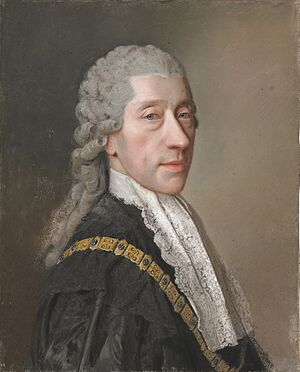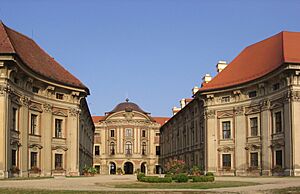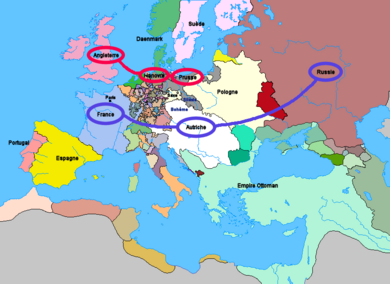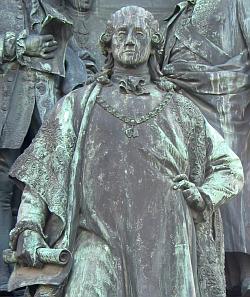Wenzel Anton, Prince of Kaunitz-Rietberg facts for kids
Quick facts for kids
Wenzel Anton von Kaunitz
Prince of Kaunitz-Rietberg
|
|
|---|---|

Portrait by Jean-Étienne Liotard, 1762. He wears the chain of the Order of the Golden Fleece.
|
|
| State Chancellor of the Habsburg monarchy | |
| In office 13 May 1753 – 19 August 1792 |
|
| Monarch | Maria Theresa (1753–1780) Joseph II (1780–1790) Leopold II (1790–1792) Francis II (1792) |
| Preceded by | Count Anton Corfiz Ulfeldt |
| Succeeded by | Philipp von Cobenzl |
| Personal details | |
| Born | 2 February 1711 Vienna, Austria, Holy Roman Empire |
| Died | 27 June 1794 (aged 83) Vienna, Austria |
| Parents |
|
Wenzel Anton, Prince of Kaunitz-Rietberg (born February 2, 1711 – died June 27, 1794) was an important Austrian and Czech diplomat and statesman. A diplomat helps countries talk to each other, and a statesman is a wise leader in government. He worked for the Habsburg monarchy, which was a powerful royal family that ruled over a large area in Europe.
Kaunitz believed in "enlightened absolutism." This meant he thought rulers should have total power but use it to make life better for their people. He was the State Chancellor (like a prime minister or chief minister) for almost 40 years. During this time, he was in charge of Austria's relationships with other countries. He served under three rulers: Maria Theresa, Joseph II, and Leopold II. In 1764, he was given the special title of a Prince.
Contents
Family Background
Wenzel Anton was born in Vienna, Austria. He was one of 19 children! His father was Maximilian Ulrich, the third Count of Kaunitz. His mother, Marie Ernestine, came from an important family in Germany.
The Kaunitz family was part of the old Czech nobility, which means they were a very important and powerful family for a long time. They were first mentioned in the 1300s. The family originally lived in a region called Silesia but later moved to Slavkov Castle (also known as Austerlitz) near Brno.
Wenzel Anton's grandfather, Dominik Andreas von Kaunitz, was a diplomat for the Habsburg rulers. He helped create an alliance of countries against King Louis XIV of France and helped end a war called the Nine Years' War. Wenzel Anton's father, Maximilian Ulrich, also held important government jobs. He was a governor in Moravia.
In 1736, Wenzel Anton married Countess Maria Ernestine von Starhemberg. They had four sons. One of their sons, Franz Wenzel, became an Austrian general. Wenzel Anton's granddaughter later married Prince Klemens von Metternich, who also became a State Chancellor.
Early Life and Career
Because Wenzel Anton was the second son, he was first expected to become a church leader. At age 13, he even held a position in a church in Germany. However, when his older brother died, he decided to work in government instead. He studied law and diplomacy at universities in Vienna, Leipzig, and Leiden.
He became a "chamberlain" for Emperor Charles VI. A chamberlain was an important official in the royal court. He also traveled around Europe to learn more, visiting cities like Berlin, Paris, and London.
When he returned to Vienna, he joined an important Imperial Council in 1735. He was sent on several diplomatic missions, including to Italy, to gain support for Maria Theresa during the War of the Austrian Succession. This was a big war where many European countries fought over who would rule Austria.
In 1744, he became a special minister in the Austrian Netherlands (which is now Belgium). He was basically in charge of the government there. However, French forces attacked, and he had to leave. He later represented Austria at the Congress of Aachen in 1748, which ended the War of the Austrian Succession. He was not happy with the peace treaty because Austria lost some land, like Silesia, to Frederick II of Prussia.
Austria and France, who had been enemies, started to think about becoming friends. Kaunitz believed that Frederick II of Prussia was Austria's biggest enemy. He thought Austria should team up with Russia and France to get back the land they lost. Empress Maria Theresa agreed with him. So, in 1750, Kaunitz became the Austrian ambassador to France. He worked to build a strong friendship between Austria and France.
Becoming State Chancellor
In 1753, Kaunitz became the State Chancellor and foreign minister. This was his most important job, and he held it for nearly 40 years! Empress Maria Theresa trusted him completely, even though her husband, Francis Stephen, didn't always agree with Kaunitz.
Kaunitz helped Austria become a powerful country. He made a peace treaty with France, which had been Austria's old enemy. This big change in alliances is known as the Diplomatic Revolution. It showed how skilled Kaunitz was at diplomacy.
The Diplomatic Revolution
Kaunitz was the main person behind the Diplomatic Revolution of 1756. This was a huge change in how countries in Europe were allied. Austria, which used to be friends with Britain, became friends with France and Russia. Prussia, on the other hand, became friends with Britain. This new setup led to the Seven Years' War.
Seven Years' War
After becoming State Chancellor, Kaunitz worked to make Austria and France closer. When a war broke out overseas in 1754 (the French and Indian War), he suggested forming a defensive alliance. France agreed after Britain and Prussia signed their own treaty in 1756. The alliance grew to include Russia and Sweden in 1757.
This led to the Seven Years' War in Europe. Austria hoped to get back the land it lost to Prussia, but it didn't happen. The war was long and costly. Kaunitz pushed for changes in the Austrian army and government to make them stronger. However, when the new Russian ruler left the alliance in 1762, Kaunitz started peace talks. The war ended in 1763 with the Treaty of Hubertusburg. After the war, Kaunitz was given the title of Prince of the Holy Roman Empire. He also helped create a small Austrian navy because the war showed Austria needed one.
Josephinism and Reforms
Kaunitz was a big supporter of education and art. He collected art and helped start the Royal Academy in Brussels. He also supported famous musicians like Christoph Willibald Gluck and Wolfgang Amadeus Mozart.
He believed the government should have more control over the Catholic Church. For example, he thought the Church should pay taxes and not own so much land. Kaunitz was influenced by the Age of Enlightenment, which was a time when people focused on reason and new ideas. He also wanted to improve education for everyone.
Maria Theresa's son, Emperor Joseph II, shared many of these ideas. However, Joseph II wanted to make changes too quickly for Kaunitz. They often disagreed, and Kaunitz offered to resign several times.
Kaunitz also wanted Austria to become friends with Prussia again. He went with Joseph II to meet Frederick II twice. Even though Frederick II found Kaunitz a bit arrogant, they did work together. This led to the First Partition of Poland in 1772, where Austria, Prussia, and Russia divided parts of Poland among themselves. Maria Theresa was worried about this, but Kaunitz and Joseph II supported it.
In 1777, Joseph II's quick actions led to the War of the Bavarian Succession. When Austria was in a difficult spot, Kaunitz took charge of the peace talks. He managed to gain the Innviertel region for Austria in the 1779 Treaty of Teschen.
Later, Kaunitz pushed for the Austro-Turkish War to try and weaken Prussia. However, this war was very expensive and didn't achieve its goal. After Joseph II died, Leopold II became emperor. Kaunitz's power began to fade. Austria's situation at home and with other countries got worse.
Later Years and Death
Leopold II blamed Kaunitz for some of the problems and limited his power. Kaunitz didn't think Austria should become too close to Prussia against Revolutionary France, and he was proven right later.
Kaunitz finally left his job in July 1792, when Francis II became emperor. He died in 1794 in Vienna and was buried in his family's tomb at Slavkov cemetery.
See also
 In Spanish: Wenzel Anton von Kaunitz-Rietberg para niños
In Spanish: Wenzel Anton von Kaunitz-Rietberg para niños





